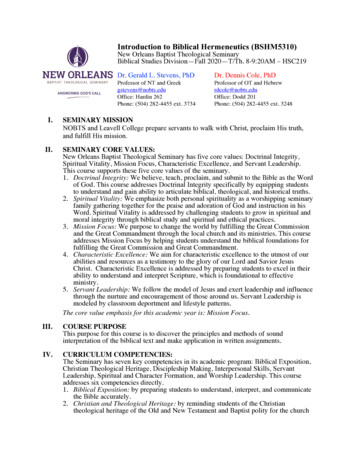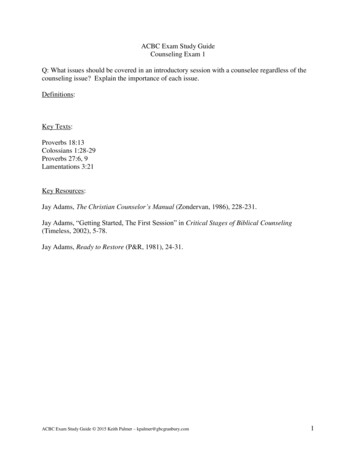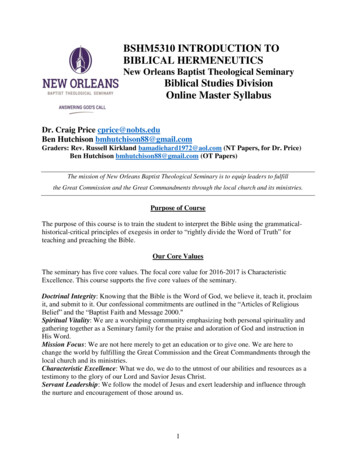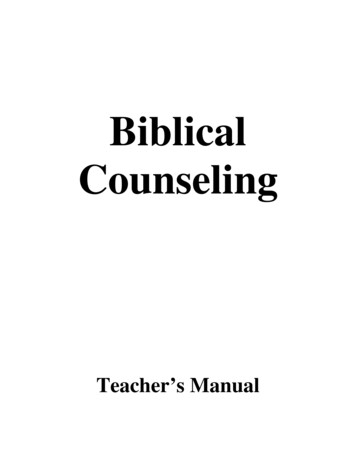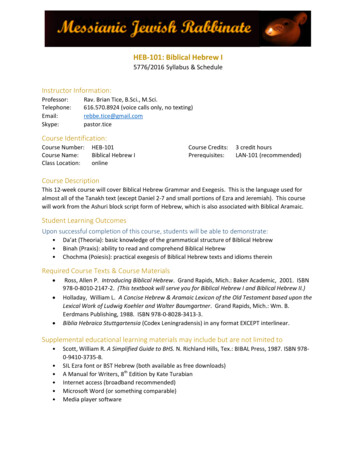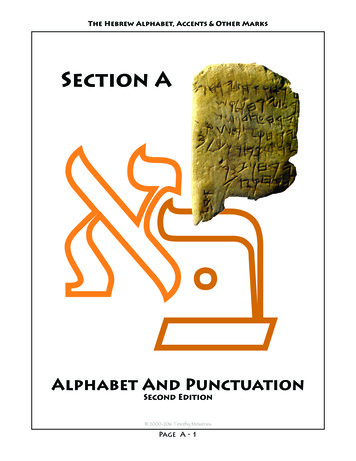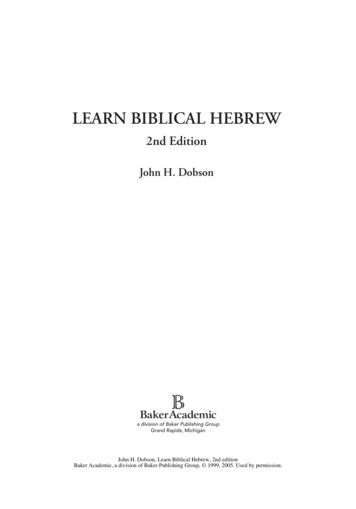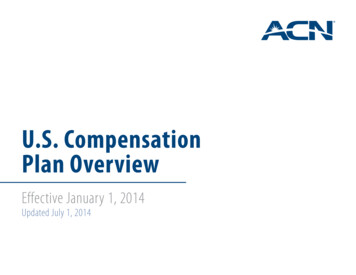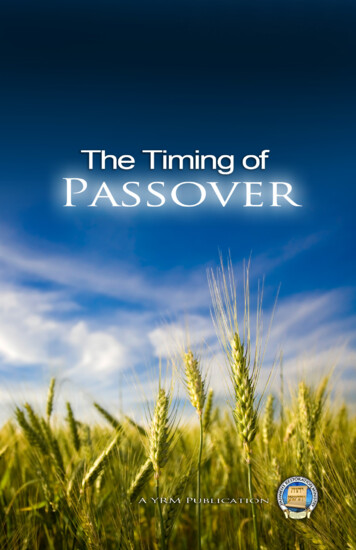
Transcription
O2ne of the most contentious topics among True Worshipersis Yahweh’s calendar, especially as it applies to Passover.Because the first Biblical month is established at Passover,observing Passover in the correct month will help ensurethat all the rest of the annual observances fall properly in the calendaryear. One teaching says that we should use the vernal equinox indetermining Passover. We discuss this issue beginning on page 10.The Passover has been misconstrued since the time Judah andBenjamin were led away captive to Babylon. From that point inhistory the Passover has gone through various transformations. AsYahweh designed it, the Passover is a memorial (moed, appointedtime) and separate from the Feast of Unleavened Bread, but Judaismlater combined the Passover and the Feast of Unleavened Bread intoone Feast and this has caused much of the problem among Feastkeepers today.Note what the Encyclopaedia Judaica says, “The feast of Passoverconsists of two parts: the Passover ceremony, and the feast ofUnleavened Bread. Originally, both parts existed separately; but atthe beginning of the [Babylonian] exile they were combined” (vol.13, p. 169).Ten specific passages relating to Passover have posed problemsfor Bible scholars and students alike. We will examine each of these.An important point to note: If our understanding does not correspondwith the original standard given by Yahweh to Israel in the OldTestament, then it is erroneous. Many go wrong here—they fail toconsider what Yahweh commanded in the Old Testament and applythose historical facts to the present. Let’s look at our first passage. “And ye shall keep it [the sacrifice] up until the fourteenth day ofthe same month: and the whole assembly of the congregation of Israelshall kill it in the evening” (Exodus 12:6, KJV).The word “even” in Exodus 12:6 does not very accurately translatethe original term. The Hebrew for the word “even” is ben ha arbayim,literally “between the two evenings.”According to modern Jewish rabbis, “between the two evenings”
3indicates a time between noon and sunset. However, most scholarsmaintain that this phrase originally signified the time between sunsetand complete darkness, which is about a 45-minute period. A numberof modern translations interpret this Hebrew phrase as beginning atsunset or twilight, including: The New International Bible, RevisedEnglish Bible, New American Bible, New Jerusalem Bible, New KingJames Bible, James Moffatt Bible, Complete Jewish Bible, LamsaBible, The Holy Scriptures (JPS), and the Jewish TANAKH.Evidence shows that the Jews began only later to define thisphrase as the time between noon and sunset. The Jerusalem Bible,in an Exodus 12:6 note, says: “Either between sunset and darkness(Samaritans) or between afternoon and sunset (Pharisees and Talmud).The Zondervan NIV Exhaustive Concordance identifies this phraseas, “evening, twilight, dusk, the fading of the day; twilight can beextended to the dark of the night.” The Brown-Driver-Briggs Hebrewand English Lexicon agrees, noting, “between the two evenings, i.e.prob. between sunset and dark.” The Harper Collins Study Bible givesthis explanation, “Twilight, lit. ‘between the two settings,’ apparentlybetween sunset and the last of the residual light in the sky.” And TheNew Strong’s Expanded Exhaustive Concordance of the Bible says,“The phrase ‘in the evening’ [literally, ‘between the evenings’] meansthe period between sunset and darkness, ‘twilight’ (Ex. 12:6; KJV,‘in the evening’).” “And this day shall be unto you for a memorial; and ye shall keepit a feast to Yahweh throughout your generations; ye shall keep it afeast by an ordinance for ever” (Exodus 12:14, KJV).Based on this verse, some Bible students believe that the Passoveris a Sabbath and first high day of the Feast of Unleavened Bread inwhich no work is permitted. The King James Bible is often difficult tounderstand and in some cases like this one offers a poor rendition ofthe original meaning. Notice that a semicolon separates “memorial”from the phrase, “and you shall keep it a feast to Yahweh ” as ifthey are two different observances. The word “it” is added (italicized),offering further evidence that the second phrase describes a Feast
4apart from the Passover.The TANAKH seems to recognize this distinction, but rendersExodus 12:14 a bit differently, “This day shall be to you one ofremembrance: You shall celebrate it as a festival to Yahweh throughoutthe ages ” The TANAKH says that we are to remember to observethe Passover “as” we might an annual feast, not that it is a feast. Theannual feasts of Yahweh are to be observed on appointed times, andto neglect these feasts is to neglect the will of Yahweh.For additional information on why Passover is not a high dayor the first day of the Feast of Unleavened Bread, write for ourcomprehensive booklet, 10 Proofs Passover Is a Memorial, Not aHigh Day (no charge). “In the first month, on thefourteenth day of the month ateven, ye shall eat unleavenedbread, until the one andtwentieth day of the month ateven” (Exodus 12:18, KJV).Those who advocate that thePassover is part of the Feast ofUnleavened Bread often usethis passage to show that boththe Passover and the Feast ofUnleavened Bread begin onthe 14th day of Abib and stopbefore the 21st day of Abib.The confusion lies in the word“until.”The word until is translated from the Hebrew word “ad,” whichcan mean up to a particular point. This same word “ad” is found inExodus 12:6, which designates the day in which the Passover lambwas slaughtered. Exodus 12:6 says that the lamb was to be kept “untilthe fourteenth day” of Abib. In other words, the Passover lambs werekept up to the 14th day, and as the 14th day began the lambs were
5slaughtered.In the Hebrew a word may have several different definitions orbe used several different ways, and such is true for the word ad. Theprimitive root of ad is adah. Adah means to advance through or gothrough a certain point in time. Therefore, knowing that the Passoverby Yahweh’s command is on the 14th day of Abib and that the Feastbegins on the 15th (Lev. 23:5-6), we can conclude that in this versethe meaning from the root word “adah” is proper.Another example of this usage of adah is found in Exodus12:15, where Yahweh says that we are to eat unleavened bread“until” the seventh day. We know from Leviticus 23:6 that we areto eat unleavened bread for seven complete days during the Feast ofUnleavened Bread, therefore showing that the word “ad” can meanthe entire duration thereof. In this case, the Feast goes through the21st, so that the Passover is not part of the seven days of the Feast. “Thou shalt not offer the blood of my sacrifice with leaven; neithershall the sacrifice of the feast of the Passover be left unto the morning”(Exodus 34:25, KJV).The Authorized Version calls the Passover a “feast” in Exodus 34:25.The word “feast” as found in the King James and many other populartranslations is from the Hebrew chag, which can mean either a feastor a type of sacrificial victim.If we examine the context of Exodus 34:25 from the King JamesBible, an inconsistency will be noticed. How can a feast be left “untothe morning”?This poor rendition by King James translators, who did not keepthe annual moedim, can be overcome by inserting the word victiminstead of feast in Exodus 34:25. According to Exodus 12, the Passoverlamb or victim was not to be left unto the morning. “And ye shalllet nothing of it [Passover animal] remain until the morning; andthat which remaineth of it until the morning ye shall burn with fire”(Exodus 12:10, KJV).By delving into the Hebrew and understanding the events of thePassover, this particular verse is made clear. A better rendition of
6Exodus 34:25 can be found in the Schocken Bible – The Five Booksof Moses: “ You are not to leave-overnight, until morning, thepilgrimage-offering of Passover.” “In the first month, in the fourteenth day of the month, ye shall havethe Passover, a Feast of seven days; unleavened bread shall be eaten”(Ezekiel 45:21, KJV).This is another verse used to support the idea that the Passover ispart of a seven-day feast. What we must remember is that this is butone translation, and likely one of the most difficult translations tounderstand. We find an improved rendering of this verse from theTANAKH: “On the fourteenth day of the first month you shall havethe Passover sacrifice; and during a festival of seven days unleavenedbread shall be eaten.”The TANAKH shows a distinct separation of the Passover fromthe Feast of Unleavened Bread in Ezekiel 45:21. The semicolon afterthe word “sacrifice” shows that the second thought is separate fromthe previous one. (Hebrew lacked punctuation, which was insertedlater by translators.)The TANAKH harmonizes with other passages telling us that thetwo observances are separate and come on different days (see Lev.23:5-6 and Num. 28:16-17, each showing clearly that Passover is onthe 14th, while the Feast of Unleavened Bread begins on the 15th). “Ye know that after two days is the feast of the Passover, and theSon of man is betrayed to be impaled” (Matthew 26:2, KJV).This passage is cited by those who advocate that the Passover is aSabbath or Feast. In all English versions of the Bible we have wordsthat were added by the translators in an effort to clarify specificpassages. Yet in some cases these words only confuse the issue andmake the original meaning difficult.The translators of the Kings James Bible added the word “feast”in Matthew 26:2. In some Bibles, like the KJV, this is indicated whenthe word is put in italics. The word “feast” is omitted from Matthew
726:2 in the New Revised Version, Revised English Bible, AmericanStandard Version, Revised Standard Version, World English Bible,New American Bible, Hebrew Names Version, New JerusalemBible, Young’s Literal Translation, New King James Version, NewInternational Bible, and the Complete Jewish Bible. “Now the first day of the feast of unleavened bread the disciplescame to Yahshua, saying unto him, Where wilt thou that we preparefor thee to eat the Passover?” (Matthew 26:17, KJV).Matthew 26:17 is also used by those who think that the Passover ispart of the Feast of Unleavened Bread. It should be first noted thatthe word “day” in Matthew 26:17 was added by KJV translators. Sothis passage, with the word “day” omitted, would read, “Now thefirst of the Feast of Unleavened Bread ”There is yet another clarification to be made, and that is that theword “first” as found in the Authorized Version can be interpreteddifferently according to the Greek. The word “first” is from the Greekword “protos” and is explained by the Complete Word Study NewTestament, “The superlative degree of pro (4253), before. First; usedof time (John 5:4; 1 Cor. 15:45, 47; 2 Tim. 4:16; Rev. 1:11, 17; 2:8);former, before, in a comparative sense, as first is often used in Eng.(Luke 2:2; John 1:15, 30, 42; 8:58; 20:4, 8; 1Cor. 14:30); or order orsituation (Acts 16:12); of dignity, first, chief, principle.”The Greek protos signifies an order of events, and more preciselyit indicates whether an event is before or concurrent with another. Weknow by the Old Testament command of Yahweh (Lev. 23:5-6) thatthe Passover was originally separate from the Feast of UnleavenedBread, and only later did the Jews combine it with the Feast.Knowing this fact, Matthew 26:17 should more accurately betranslated, “Now before [Gk. protos] the feast of unleavened bread thedisciples came to Yahshua, saying unto him, Where wilt thou that weprepare for thee to eat the Passover?” The Passover cannot be the firstday of the Feast because the first day is a high day and no preparationwork would be allowed—including purchasing unleavened bread. Itwas on the Passover that the disciples assumed that Judas was goingto purchase Feast supplies, John 13:29, an assumption they never
8would have made had Passover been a High Day of the Feast.Some believe that Yahshua ate only what the Jews call a sederthat Passover night, but in Matthew 26:18 Yahshua plainly said thatHe would keep the Passover at a certain house with His disciples.According to Yahweh’s law, if a person neglects to partake ofthe Passover, he will be cut off. “But the man that is clean, and isnot in a journey, and forbears to keep the passover, even the samesoul shall be cut off from among his people: because he brought notthe offering of Yahweh in his appointed season, that man shall bearhis sin” (Numbers 9:13). Yahshua obviously understood this law,and would by all means comply with the command to observe thePassover.If Yahshua had neglected that last Passover, as some suppose, ourSavior would have committed a sin and would Himself have beencut off! The Scripture confirms that He was sinless, 1Peter 2:22, andconsequently we also know that He kept the Passover according tothe law. “Now the feast of unleavened bread drew nigh, which is called thePassover” (Luke 22:1, KJV).Note the phrase, “which is called the Passover.” At that time therewere two major Jewish sects, the Pharisees and the Sadducees.Historically it is known that the Pharisees kept the Passover and theFeast of Unleavened Bread as one single Feast, just as modern Judaismdoes today, while the Sadducess kept two separate observances:the Passover on the fourteenth and the Feast of Unleavened on thefifteenth day of Abib. It is also widely known that while the Phariseesplaced more authority on their own rabbinical teachings (Talmud)than they did on the Scriptures, the Sadducees accepted the Torahas their only source of truth.Knowing that these differences existed when Luke wrote hisEvangel, it is no wonder that he wrote “which is called the Passover.”There were those who kept the Passover as the first day of the Feastof Unleavened Bread. The Revised English Bible perhaps delivers aclearer interpretation than the Authorized Version: “The festival of
9Unleavened Bread, known as Passover, was approaching.” It is clearthat Luke is not stating that the Passover and Feast of UnleavenedBread are the same Feast, but that some considered the Feast thePassover, no doubt because the one came immediately after the other. “Then came the day of unleavened bread, when the Passover mustbe killed” (Luke 22:7, KJV).Here is another passage that appears to be stating that the Passoverlamb was slaughtered during the Feast of Unleavened Bread. Todiscern the original intent of this specific passage, an understandingof the Greek is essential. The Greek word for “day” in the abovepassage is hemera. Strong’s Exhaustive Concordance of the Bibleoffers the following definition: “ the time space between dawn anddark, or the whole 24 hours fig. a period (always defined more orless clearly by the context).” Strong’s offers two different definitionsfor the Greek hemera — either as a literal 24-hour span or figurativelyas a period that is normally defined by the context of the passage.We know from the Old Testament and Yahweh’s instructionsthat the Passover was separate from the Feast of Unleavened Bread,therefore, we know that the Passover lambs were not slaughteredduring the Feast of Unleavened Bread. In addition, we also knowthat it was during the period of the Feast of Unleavened Bread thatthe Passover lambs were killed. Just as people today refer to thePassover by simply saying the Feast of Unleavened Bread, Luke doesthe same by stating, “Then came the hemera [period] of unleavenedbread, when the Passover must be killed.” “And it was the third hour, and they impaled him” (Mark 15:25,KJV).Many believe that Yahshua was impaled at 9:00 a.m., but accordingto John, Yahshua was not yet convicted by that time: “And it wasthe preparation of the Passover, and about the sixth hour: and hesaith unto the Jews, Behold your King!” (John 19:14). Accordingto John, Yahshua was convicted about the sixth hour, which would
10be from 11:30 a.m. to 12:30 p.m. How could He be impaled beforebeing sentenced?In addition, Matthew 27:45, Mark 15:33, and Luke 23:44 all statethat there was darkness over the land from the sixth to the ninth hour.The fact is, no other passage referring to Yahshua’s impalementmentions the third hour. Mark 15:25 has offered a challenge to Biblicalscholars from the start.There are two possible explanations for this inconsistency. Thefirst requires some background on how the Jews defined day andnight hours. They broke both the day and night into four equal partsof three hours each: 6:00 a.m. to 9:00 a.m; 9:00 a.m. to noon; noonto 3:00 p.m., and 3:00 p.m. to 6:00 p.m.Mark could have possibly been using the Jewish method ofcalculating time in Mark 15:25.According to the Commentary on the New Testament, “Markdivides the day into four quarters as he does the night; the secondquarter, from nine in the morning until midday, he names after thehour with which it begins; hence, our L-rd was condemned by Pilateand crucified shortly before midday” (p. 224).We can conclude that Yahshua was convicted roughly beforenoon, impaled shortly thereafter, and died at 3:00 p.m.The other explanation is that the word “third” in Mark 15:25 couldbe a mistranslation. In ancient texts, numbers are often representedwith letters. If this were the case in Mark 15:25, it is quite possible thata mistranslation could have occurred due to the similarities betweenthe Greek letters that represent the numbers six and nine. We maynever know exactly what time of day Yahshua was convicted andimpaled, but we do know that according to three of the Evangels thatthese events occurred from the sixth to the ninth hour — noon to 3p.m.Equinox or Barley?All of Yahweh’s seven annual Feasts or moedim (appointments)revolve around the harvest cycle of grains and other produce. This isclear with the Passover and Feast of Unleavened Bread, which occurat the barley harvest (Ex. 9:31, Deut. 16:9).
11These observances are followed by the Feast of Firstfruits, alsoknown as Pentecost in the New Testament. This special time occursseven weeks after Unleavened Bread and represents the firstfruits ofthe wheat harvest made into two loaves of bread that were waved(presented before Yahweh, Lev. 23:17). Then in the seventh monthwe come to the Feast of Tabernacles, otherwise known as the “Feastof Ingathering” (Ex. 23:16). Tabernacles represents the general harvestat the close of the growing cycle when everything is “gathered in”—from grains to vegetables, melons, nuts, and fruit.Clearly, the variousharvests are central toYahweh’s Feasts. Theharvests propheticallypoint to the harvestof souls in Yahweh’sgreat salvation plan— from the firstfruits,which represent Hiselect people in the firstresurrection, to the general harvest of souls after the Millennium.Even the first month of the sacred year is named Abib, which inHebrew means “tender, green ears.” The “ears” refer to barley grainin the ear of the stock, the only grain mature enough at the time ofthe Passover to be green and in the head. Exodus 9:31 reads, “Andthe flax and the barley was smitten: for the barley was in the ear, andthe flax was bolled” [bolled podded, No. 1392, Heb. gibol]. “32:But the wheat and the rie were not smitten: for they were not grownup.” Therefore, Yahweh says, “This month shall be unto you thebeginning of months: it shall be the first month of the year to you,”Exodus 12:2. “This day came you out in the month Abib,” Exodus13:4.The state of the crops, especially the barley and flax, is the onlycriterion that Yahweh gives for establishing the timing of the firstmonth of the year. Nothing in the Bible explains how to establishthe first month of the year in any other fashion than the developing
12green ears of barley.In the spirit of maturing crops, we are to establish and observethe first month – when the barley grain is green, Leviticus 23:14(note the words “parched,” meaning roasted, and “green”). Bakingor parching the green barley dried it. This was not ripe, dry barley, itwas young and green barley. We cannot establish Abib if the barleyhead is not developed or if the barley seed is dry, ripe, golden andready to harvest; by then it is too late. The barley must be green andthis occurs at a specific time in a specific month.Where Do We Look?Can we look at the barley crop growing in our own vicinity to establishAbib? We will find a difference in maturity of several weeks betweenbarley ripening in southern Texas and barley growing in NorthDakota. Therefore, the timing of Abib could vary widely dependingon where one lives. Ostensibly, believers living at different latitudescould follow calendars that differ by a month or two if one goes bythe local barley crop.The only way to reconcile this discrepancy in growing seasons isto look at the barley that is grown in or around Israel. And that makesperfect sense, because it was to people living in that area of the worldthat Yahweh gave the command during the green ear month of Abibto keep the Passover and Feast. It is that area of the world that willgive us the proper and accurate time based on the barely growingthere when Yahweh commanded Israel to keep the first month.Interestingly, barley originated in the Mediterranean region. Howappropriate, then, that we look at the barley growing in the MiddleEast, and not barley grown in North Dakota, Texas, Australia orsomewhere else to establish Abib.The law provides that the wave sheaf be of the firstfruits of barley.Whatever barley field produced first, from that crop the wave sheafwas taken. Once the wave sheaf was offered to Yahweh, the harvestcould begin. Harvesting of barley takes place in early April nearJericho. Abib barley has been reported by the middle of March in
13the Middle East.The explanation of why only the barley and flax were damagedby the plague of hail in Egypt (Ex. 9:31) brings up an important pointmany miss: “ for the barley was in the ear, and the flax was bolled.”“Bolled” is from the Hebrew gibol and means swollen, podded, in thebud. Therefore, one could use the flax plant as a second confirmationfor the month of Abib by examining whether it is in the pod at thattime.Why Not Use the Equinox?Some ignore barley altogether and set Abib 1 according to the vernalequinox. The vernal equinox is that instant when the sun is positioneddirectly over the earth’s equator in its yearly migration from southto north. It is the time that astronomers define as the beginning ofspring when days and nights are equal in length. (Yet there are stillseveral days difference between equal night and day at the equatorand equal night and day in the northern hemisphere where Israel andthe U.S. are located.)Those who employ the vernal equinox point to Genesis 1:14,claiming that the sun, moon, and stars set the Feasts. It is true thatthe sun divides day from night and brings about the seasons, whilethe new moon sets the beginning of months. Nowhere in the entireBible, however, can one find where the vernal equinox establishesAbib, nor is there one verse referring to the vernal equinox.The King James Version has led some astray in the way it translatesmoed in Exodus 13:10, Num. 9:2, 3, 7, and 13. The KJV uses“season” in these verses, causing some to believe that the command isspecifically for a spring season Passover, and therefore must involvethe vernal equinox. In reality, the Hebrew moed simply means “settime” or “appointed time.” Yahweh has set Passover and the Feastof Unleavened Bread by crop growth, not by a man-made definitionfor when spring beings (the equinox).Passover is related to spring only through the growing cycle ofcrops. First and foremost, it must occur in the month of Abib. Abib
14itself hinges on the condition of grain, not a season.Photo: Anatoly TerentievEquinox and Historic PaganismWhen the Roman church deliberately acted to separate Easter fromPassover, it ruled in 325 CE in the Council of Nicaea that Easter wouldfall on the first Sunday after the first full moon following the vernalequinox. This setting of an observance was entirely man-made, andappropriately applied to a similarly man-made holiday called Easter.Persian Nowruz pagan relief. on the day of an equinox, the power of an eternally fighting bull (personifying the Earth) and that of a lion(personifying the Sun) are equal.The Roman church, acting on its own authority, bestowed alegitimacy to the vernal equinox as a calendar marker even though itlacks such in a Biblical context. That does not mean, however, thatthe vernal equinox had no significance among historic pagans andtheir calendars. (See more about this on our web page at yrm.org)‘Tequphah’ Is not the EquinoxThe argument has been attempted that the vernal equinox correspondsto the Hebrew word “tequphah,” which is found four times in theBible. The definition of tequphah (Strong’s Concordance No. 8622)
15is: “A revolution, i.e. of the sun course (of time) lapse: circuit, comeabout, end.” From the definition, we find it next to impossible toattach any certain connection of tequphah to a spring equinox. Theevidence, in fact, points to the end of the year, not the beginning.The following passages contain the Hebrew word tequphah aswell as its meaning, as indicated by the quotation marks: Exodus 34:22 (Feast of ingathering at the “year’s end”) 2Chron. 24:23 (Syria attacked Judah at the “end of the year”) 2Chronicles. 24:23; 36:10 (“end of the year/year was expired”)Brown, Driver, Briggs Hebrew and English Lexicon defines thetequphah (Strong’s No. 8622) as: “coming round, circuit;—Ex. 34:22,adv., at the circuit (completion) of the year, so 2Chron. 24:23 pl.cstr. 1Sam. 1:20; sig. Sf. Of finished circuit of sun.” p. 880This lexicon says about the root of tequphah: “No. 5362 naqaph:1. An intransitive verb meaning to surround something (Isa. 29:1,let feasts go around, i.e. run the round (of the year). 2. make theround, i.e. complete the circuit. Job 1:5 when the days of feastinghad completed their circuit.”The closest we have in the Bible to spring as a season is 6779,tsamach, a primitive root meaning to sprout, bear, bring forth, bud,grow, cause to spring (forth, up). The Bible’s “spring” is determinedby crops, not by solar positioning.Yahweh’s Feasts are agricultural in nature. It is this fact thatbinds them to the Biblical theme of salvation through the spirituallymaturing and “harvesting” of souls for the Kingdom, which will occurwhen the angels come to weed out the tares and gather the elect forthe Kingdom, Matthew 13:30. May you be counted among the goodproduce at that final harvest for Yahweh’s Kingdom because youwere obedient in all things.Copyright 2002 Yahweh’s Restoration Ministry. All rights reserved.
English Bible, New American Bible, New Jerusalem Bible, New King James Bible, James Moffatt Bible, Complete Jewish Bible, Lamsa Bible, The Holy Scriptures (JPS), and the Jewish TANAKH. Evidence shows that the Jews began only later to define this phrase as the time between noon and sunset. The Jerusalem Bible, in an Exodus 12:6 note, says .

